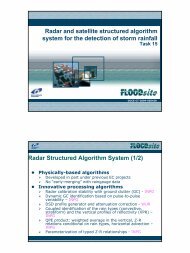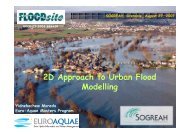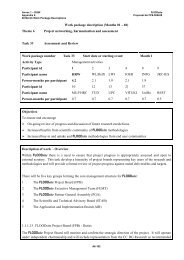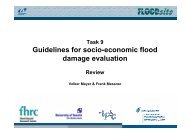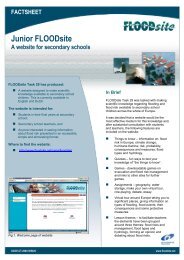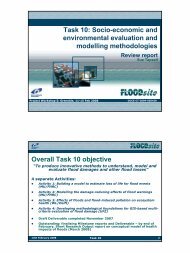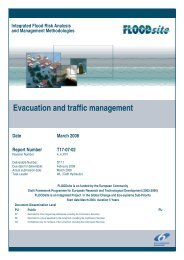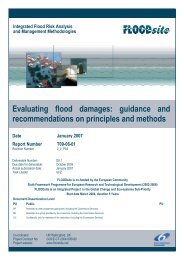Language of Risk - FLOODsite
Language of Risk - FLOODsite
Language of Risk - FLOODsite
You also want an ePaper? Increase the reach of your titles
YUMPU automatically turns print PDFs into web optimized ePapers that Google loves.
<strong>FLOODsite</strong> <strong>Language</strong> <strong>of</strong> <strong>Risk</strong> 2 nd Ed.<br />
Contract No:GOCE-CT-2004-505420<br />
5. Glossary<br />
In the glossary below, some <strong>of</strong> the terms arose from the work <strong>of</strong> the <strong>FLOODsite</strong> tasks; in these cases<br />
the task number is provided as (Task N)<br />
Accuracy - closeness to reality.<br />
Adaptive capacity - Is the ability to plan, prepare for, facilitate, and implement adaptation options.<br />
Factors that determine a community adaptive capacity include its economic wealth, its technology and<br />
infrastructure, the information, knowledge and skills that it possesses, the nature <strong>of</strong> its institutions, its<br />
commitment to equity, and its social capital.<br />
Aims - The objectives <strong>of</strong> groups/individuals/organisations involved with a project. The aims are taken<br />
to include ethical and aesthetic considerations.<br />
Attenuation (flood peak) - lowering a flood peak (and lengthening its base).<br />
Basin (river) (see catchment area) - the area from which water runs <strong>of</strong>f to a given river.<br />
Beach Overwash (Task 5)<br />
Beach overwash can be defined as the flow <strong>of</strong> water and sediment over the crest <strong>of</strong> a beach that does<br />
not directly return to the water body from which it originated.<br />
Bias - The disposition to distort the significance <strong>of</strong> the various pieces <strong>of</strong> information that have to be<br />
used.<br />
Catchment area - the area from which water runs <strong>of</strong>f to a river<br />
Characterisation - The process <strong>of</strong> expressing the observed/predicted behaviour <strong>of</strong> a system and it's<br />
components for optimal use in decision making.<br />
Coastal Dune (Task 5)<br />
A coastal dune is a ridge or mound <strong>of</strong> loose wind-blown material, usually sand, located on the<br />
landward side <strong>of</strong> the beach.<br />
Cognition - The conscious or unconscious process <strong>of</strong> deriving meaning from sensory data. So<br />
‘perceived risk’ might be more correctly termed “cognated” risk.<br />
Conditional probability - The likelihood <strong>of</strong> some event given the prior occurrence <strong>of</strong> some other<br />
event.<br />
Confidence interval - A measure <strong>of</strong> the degree <strong>of</strong> (un)certainty <strong>of</strong> an estimate. Usually presented as a<br />
percentage. For example, a confidence level <strong>of</strong> 95% applied to an upper and lower bound <strong>of</strong> an<br />
estimate indicates there is a 95% chance the estimate lies between the specified bounds. Confidence<br />
limits can be calculated for some forms <strong>of</strong> uncertainty (see knowledge uncertainty), or estimated by an<br />
expert (see judgement).<br />
Consequence - An impact such as economic, social or environmental damage/improvement that may<br />
result from a flood. May be expressed quantitatively (e.g. monetary value), by category (e.g. High,<br />
Medium, Low) or descriptively.<br />
Coping capacity — The means by which people or organisations use available resources and abilities<br />
to face adverse consequences that could lead to a disaster.<br />
T32_04_01_ <strong>FLOODsite</strong>_<strong>Language</strong>_<strong>of</strong>_<strong>Risk</strong>_D32_2_v5_2_P1 30 April 2009<br />
22



